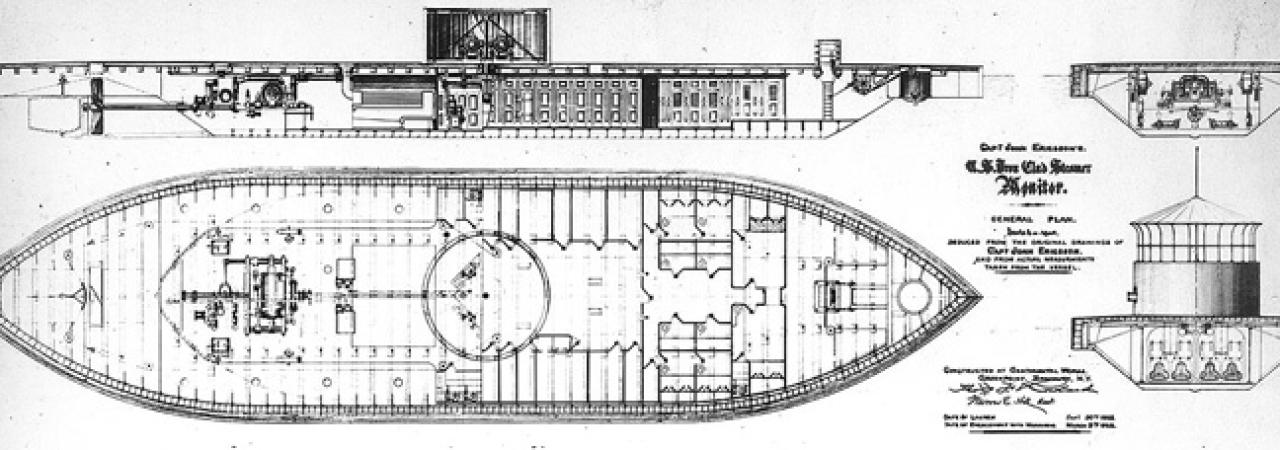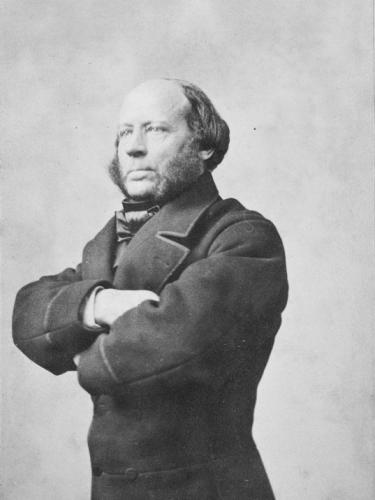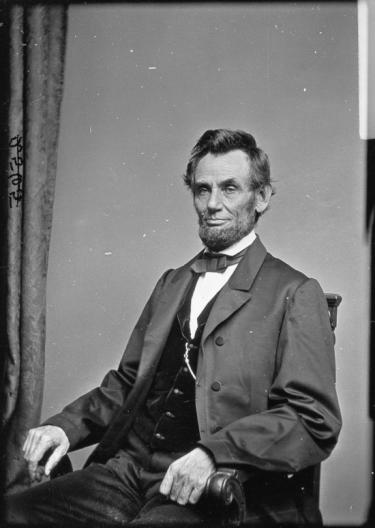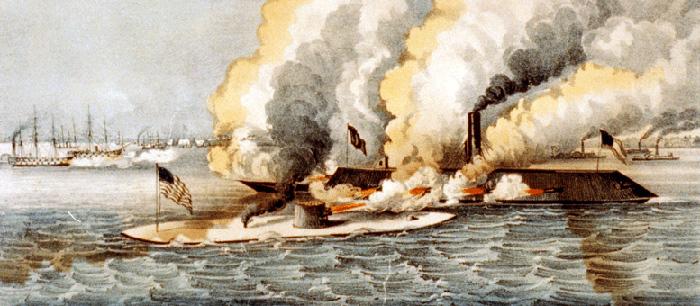

Few ships in American naval history have been so highly acclaimed as USS Monitor, a vessel that transformed naval warfare with its revolving turret. When Monitor, armed with only two cannons, fought the much more heavily armed CSS Virginia (constructed on the hull of USS Merrimac) to a draw on March 9, 1862, the world took note. In 1870 the British Admiralty built the turreted Captain. Decades later, in 1937, Winston Churchill wrote, 'The combat of the Merrimac and the Monitor made the greatest change in the sea-fighting since cannon fire by gunpowder had been mounted on ships about four hundred years before.'
The revolutionary Monitor nearly didn't get built. Controversy raged over engineer John Ericsson's design, and Abraham Lincoln had to intercede on behalf of the ship.
After the Civil War's outbreak in April 1861, shipyards in the North hummed and clanked with the efforts of thousands of workmen building 47 new wooden vessels ranging from 300 to more than 2,000 tons. There was no time to waste if the planned blockade of Southern ports was to be successful. Lincoln's navy lagged far behind the Southern counterpart in accepting innovations. In May 1861, the Confederates raised the sunken frigate USS Merrimac — which had been burned to the waterline by retreating Union tars — and began converting it into a large ironclad gunboat, CSS Virginia, at the Gosport Navy Yard in Portsmouth, Va.
In a belated response, during an extra session of the U.S. Congress convened on July 4, 1861, at Lincoln's recommendation, a report was submitted that noted the Confederacy was constructing an armored vessel. The paper recommended the construction of 'one or more ironclad steamers or floating batteries, and to select a proper and competent board to inquire into and report in regard to a measure so important.' A month later Congress authorized the creation of an 'Ironclad Board of three skillful naval officers' to decide on new warships and appropriated $1.5 million for armored vessels. On August 7, 1861, Gideon Welles, whom Lincoln had appointed secretary of the Navy in March 1861, advertised for proposals for 'impregnable' warships, related to the construction of 'One or more ironclad steam vessels of war...for either sea or river service to be no less than ten or sixteen feet draught of water...The smaller draughts of water...will be preferred.' A bit of orthodoxy crept into the request with the stipulations that such vessels were to be 'rigged with two masts, with wire rope standing rigging, to navigate at sea...'
Enter John Ericsson
Swedish-born engineer John Ericsson was one of the designers who read Welles' notice with particular interest. Ericsson was a child prodigy who had worked with his father designing canals in his native country as a teenager.
By his late teens, he was an engineer officer in the Swedish army. In 1826 he resigned that post and moved to England, where he devoted himself to building steam engines, many of which were radically different in design, but which also contained flaws that made them impractical.
At the urging of U.S. naval officer John Stockton, Ericsson moved to New York in 1839. Stockton was from a prominent, connected New Jersey family, and he helped get funds allocated to Ericsson for the development of a ship powered by an innovative screw propeller system, which was launched as USS Princeton in 1843.

Things got complicated, however, as the ship neared completion. Stockton and Ericsson bickered, and the officer began to do what he could to relegate the inventor to the background. Ericsson had designed a huge cannon with a 12-inch muzzle, mounted on a revolving platform, for Princeton. Jealous, Stockton copied the cannon on his own to try and claim credit for the design.
Stockton did not understand how to properly construct the breech-reinforcing pieces for his copy, however, and during an 1844 Potomac River demonstration run attended by President John Tyler's secretary of state, Abel P. Upshur, and Secretary of the Navy Thomas Gilmer and other dignitaries, Stockton's gun exploded. Upshur, Gilmer and six others were killed.
Ericsson, a foreigner, became the scapegoat on which Stockton blamed the tragedy — no matter that nothing Ericsson had designed or built was the problem. The Swede quickly became persona non grata to the Navy, and he consequently resented the Navy's reaction. In the 1850s he drafted some designs for iron-sheathed ships for Napoleon III of France, including a curious iron vessel with a rotating cupola, but nothing came of that effort.
Now, after many painful years of misunderstanding and neglect, Ericsson believed the time had come to show what he could do to revolutionize naval construction and help the Union win the war. He was convinced that 'victory will rest upon the side which holds possession of the seas, and I will offer my services to the Federal Government to assure that its navy will dominate.'
Full of confidence, he submitted his plan for a 'subaquatic ironclad vessel with a gun turret' directly to the president. In part his letter of August 29, 1861, read:
His Excellency Abraham Lincoln
President of the United StatesSir: The writer, having introduced the present system of naval propulsion and constructed the first screw ship of war, now offers to construct a vessel for destruction of the rebel fleet at Norfolk and for scouring the Southern rivers and inlets of all craft protected by rebel batteries...in making this offer I seek no private advantage or emolument of any kind. Attachment to the Union alone impels me to offer my services at this fearful crisis — my life if need be — in the great cause which Providence has called you to defend.
Apart from the fact that the proposed vessel is very simple in construction, due weight, I respectfully submit, should be given to the circumstance that its projector possesses practical and constructive skill shared by no engineer now living. I have planned upward of one hundred marine engines and I furnish daily, working-plans made of my own hands of mechanical and naval structures of various kinds, and I have done so for thirty years. Besides this I have received military education and feel at home in the science of artillery. You will not, Sir, attribute these statements to any other cause than my anxiety to prove that you may safely entrust me with the work I propose. If you cannot do so then the country must lose the benefit of my proffered services.
Fearing his letter might be intercepted, he did not include actual drawings of the ship, and added the following note of caution: 'At the moment of putting this communication under envelope it occurs to me finally that it is unsafe to trust the plans to the mails. Therefore I respectfully suggest that you reflect on my proposition. Should you decide to put the work in hand, if my plan meets your approbation, please telegraph and within forty-eight hours the writer will report himself at the White House.'
Ericsson anxiously awaited an answer, but his letter had been redirected, and his proposal was rejected by the Navy's chief engineers, Benjamin Isherwood and John Lenthall, who were jealous of Ericsson and considered ironclads 'humbug.'
Lucky Coincidence
In September 1861, the Ironclad Board, which consisted of Captains Hiram Paulding, Joseph Smith and Charles Davis, recommended that two contracts be let. One contract went to Cornelius Bushnell of New Haven, Conn., for Galena, and the other to Merrick & Sons, Philadelphia, for new ironclads. Both were conventional masted and sparred iron-plated broadside warships.
Ericsson was disappointed and depressed. Then he received an unexpected visitor at his home on Franklin Street: Cornelius Bushnell. Bushnell was concerned because naval authorities doubted whether Galena would be able to carry the stipulated amount of 400 tons of armor on her topsides. Bushnell had been told to consult with Ericsson on the matter.
Ericsson happily received his guest and advised him on the matter. As Bushnell prepared to leave, Ericsson asked if he was interested to see his own plans for a totally new type of low-draft ironclad warship. Ericsson showed him the latest version of the model of his 'Cupola Vessel' and copies of drawings for his proposal to President Lincoln.
The ship looked simple enough, a raft with a gun turret in the middle. Ericsson boasted that it was secure against the heaviest shot and designed for action in shallow coastal waters like Hampton Roads and Southern rivers. He explained that even in narrow passages it could operate its guns in battle, since only the turret needed to be turned.
Abraham Lincoln's Role

Bushnell was impressed and urged Ericsson to present his model and plans to the secretary of the Navy. As Ericsson was reluctant to do so, Bushnell asked if he might take them, and Ericsson agreed. Bushnell then took the plans to his old friend, Welles, at his home in Hartford, Conn.
The timing was good, because Welles was worried. He had just been informed that since June the South had been pushing forward work on Virginia. Welles urged that the model and plans be taken to Washington for further scrutiny by the Ironclad Board. Bushnell agreed, and well aware of the difficulties of dealing with the board, he managed to arrange an appointment with Abraham Lincoln.
On September 12, Lincoln received Bushnell in the White House. The unique features of Ericsson's raft-like design and turret impressed the president, and he accompanied Bushnell to the Navy Department, where they met with the Ironclad Board the following day for a discussion. Assistant Secretary of the Navy Gustavus Fox was present, as were several other naval officers. They all listened intently to Bushnell's presentation. There were many negative murmurs in the room, and opinion was split on the peculiar warship, but the president openly backed it. As he was holding the pasteboard model, studying its unique features, he remarked: 'All I have to say is what the girl said when she stuck her foot in the stocking. It strikes me there's something in it.'
The next day the board held an official meeting to decide on Ericsson's proposal. The ship was unlike anything they had ever seen or even imagined before, and the very mention of Ericsson's name made them suspicious. In the ensuing discussion, Paulding and Smith agreed to proceed with construction because the boat was inexpensive and could be ready in three months.
The third member, Captain Davis, had witnessed the Princeton tragedy and did not trust Ericsson. He handed back the model to Bushnell and, paraphrasing a Bible text, said: 'Take it home and worship it. It will not be idolatry. It is the image of nothing in the heaven above, or the earth beneath, or the waters under the earth.'
That same evening Bushnell left for New York. When he met Ericsson the next morning, he tried to appeal to his vanity, saying: 'The Board has been very impressed by your ingenious floating battery but one member, Commander Davis, only needs some further explanation about your design before signing a contract, details I was unable to explain. Therefore Secretary Welles suggested you come to Washington to give a personal explanation.'
Ericsson agreed to leave immediately for the capital and took the night train to Washington. Great was Ericsson's surprise when he heard that his plan had been rejected by the junior member, Captain Davis. When confronted by Ericsson, Davis said, 'Your ship, Captain Ericsson, lacks stability.' The inventor proceeded to defend his creation with detailed knowledge and numbers and pointed out that the low freeboard of his vessel in no way made it unstable. In fact, he said from his own experience with rafts in Sweden he knew that high seas washed over the decks, but the body of the ship itself remained steady.
He concluded, 'Gentlemen, after what I have said, I consider it to be your duty to the country to give me an order to build the vessel before I leave this room.' Davis relented and reluctantly recommended construction as an experiment. Ericsson was asked to return in an hour, and only five minutes after he was ushered into the room, Welles told him to 'go ahead and start building as soon as possible; don't wait for a formal contract.' Ericsson and his strange little ship were suddenly at the forefront of the Union's ironclad race.
A contract for 'an ironclad, shot-proof steam battery' was issued on October 4, 1861. The contract for building it stipulated a money-back clause if it proved to be a failure. Furthermore, it specified that the vessel must be provided with masts and sails and that it should make 6 knots under sail and 8 knots under steam. It was also agreed 'that said vessel and equipment in all respects shall be completed and ready for sea in one hundred days from the date of this indenture.'

Monitor was built from scratch in an amazingly short amount of time; some accounts claim it took 98 days. Contractors throughout the Northeast scrambled to provide the necessary iron plate, and foundries worked overtime to cast the boat's intricate machinery. The remarkable vessel contained 40 patentable inventions.
The ship was launched on January 30, 1862, from Continental Iron Works in Greenpoint, Brooklyn, N.Y., and was fitted out with two massive 11-inch Dahlgren guns. Its crew spent the next several weeks working out the brand-new boat's kinks. Its unique appearance earned the vessel the nickname 'cheesebox on a raft.'
Ironclad Duel
On March 8, Virginia steamed into Hampton Roads and made short work of USS Cumberland and Congress. With USS Minnesota aground, Virginia steamed off with the falling tide, its crew confident that they could return and finish the job. The entire U.S. Navy fleet, not to mention Maj. Gen. George B. McClellan's impending Peninsula campaign, seemed vulnerable to the new threat.
That next day, however, Virginia's crew got a surprise. Monitor had arrived under tow from New York the previous evening, battered from her journey, but ready to fight. The ship stood between the Confederate ironclad and the stricken Minnesota. For more than four hours the iron beasts blasted away at each other.
Virginia's guns raked the ironclad, and friendly fire also dented Monitor's armor. The Rebel ship even rammed Monitor, and a shell landed a direct hit on the pilothouse, temporarily blinding Captain John Worden and forcing him to turn over command to Lieutenant Samuel Dana Greene. But Monitor gave as good as it got, and its Dahlgrens defiantly pounded away at Virginia.

When the day ended, Virginia steamed away with the mission of destroying Minnesota unfulfilled. The two ironclads maintained an uneasy stalemate on their respective sides of Hampton Roads. One officer on Monitor commented, 'Each party steamed back & forth before their respective friends till dinner time...the same comedy I suppose will be enacted day after day for I don't know how long...'
Kept at bay by Monitor, Virginia was eventually destroyed by her own crew after it was forced to a shallow part of the James by the advance of McClellan's campaign. Ericsson would keep his money. His 'cheesebox' had forever changed the face of naval warfare.
Related Battles
369
24


